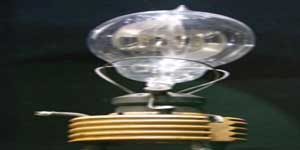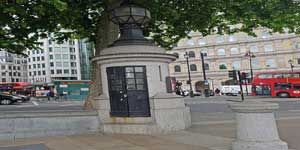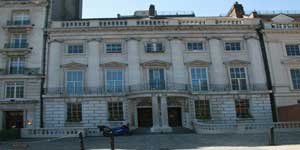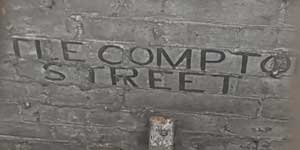
The West End of London is a sprawling and varied area that encompasses both the seat of government and the home of royalty.
It is also comprised of a sequence of villages that, although now, very much, a part of the urban sprawl that is London, were once distinctive enclaves in their own rights.
The result is that the West End boasts a varied collection of curious and offbeat items and places, and uncovering them can prove both fun and fascinating.

Meggie Albanesi is, today, a largely forgotten figure. But in the early 1920's she was acclaimed as one of the brightest young actresses of her generation.
All that now remembers her is a plaque on a wall at St Martin's Theatre.

In March 2012 the Crown Estate unveiled a plaque on the spot in Heddon Street where, in 1972, David Bowie posed for the cover of his album The Rise and Fall of Ziggy Stardust and the Spiders From Mars.
The unveiling was performed by Bowie fan Gary Kemp and several members of the original Spiders were in attendance.

This tiny little shop, tucked away down Portsmouth Street, claims to be the shop that immortalised Charles Dickens's novel The Old Curiosity Shop.
However, the claim has long been the subject of debate, with many dismissing the fact that it had any connection at all to the novel!

The Newman Arms pub on Rathbone Street is a West End institution and has been frequented by a rich array of London greats that include Winston Churchill, George Orwell and Dylan Thomas.
For many years its landlord was Joe Jenkins, a true character who was renowned for regularly swearing at his customers!

In its time the building that houses the Newman Arms on Rathbone Street has been put to a variety of uses.
However, just before becoming a pub, it was, reputedly, a brothel and, on the wall of the top storey, often unnoticed by passersby, a girl in a white nightdress remembers this intriguing period in the pub's long history.

On display at University College London is an early Edison Light bulb, together with the poster that the company put out to instruct people on its correct use.
Evidently there was some confusion as to how this new fangled lighting method worked as the poster advises people that you don't need a match to light the bulb!

Jeremy Bentham is considered the spiritual father of University College London and so it is, perhaps fitting that his mummified remains, or auto-icon, are on display in the University's South Cloister.
Here we tell the story of how he came to be here and of some of the bizarre myths surrounding him.

One of the Curiosities that you will find in the backstreets around Covent Garden is the Neal's Yard Water Clock located on a wall in Shorts Gardens.
It was created in 1982 by horologists Tim Hunkin and Andy Plant and has been delighting visitors and residents alike ever since.

In 1997, artist Rick Buckley placed casts of his own nose on various walls around the West End of London in protest at the CCTV cameras that were then springing up around the streets.
Some were taken down immediately, but seven of them have survived to create the legend of The Seven Noses of Soho.
Richard Jones sets off to sniff them out.

When Whitehall Palace was consumed by fire in the late 17th Century, the Earls of Harrington spotted an opportunity to enhance their family's standing and purchased a plot of land next to the smouldering ruins of the palace.
Sadly, things didn't turn out as planned.

Carting Lane is a seemingly incongruous thoroughfare that runs between Strand and Embankment. It looks as though there is little here to draw your attention
Yet, half way along it, there stands London's only surviving sewer-powered gas lamp or, to give it its correct title, "sewer gas destructor lamp".

In Kensington Gardens you will encounter strange little figures of elves, fairies, imps and gnomes clinging to the hollowed out stump of an old oak tree.
This curious sculpture is the Elfin Tree, and it was created in 1920 by the artist Ivor Innes. It has delighted children and adults alike ever since..

Across the road from Nelson's Column, on Trafalgar Square, you will find an arcade of shops the facade of which is adorned by carved faces and sundry creatures.
This was the work of the sculptor Barry Baldwin and it is an artwork entitled "Endangered Species."

on a wall in the Dolphin Tavern, in Red Lion Street, there is a battered old clock, the hands of which are forever frozen at 10.40pm.
This was the moment when a Zeppelin Airship dropped a bomb on the pub in 1915 and reduced the building to a twisted mass of rubble.

Inside the lovely church of Notre Dame de France, you will find a set of three murals that depict scenes from the life of the Virgin, Mary.
They were created by Jean Cocteau and they are considered the artistic highlight of the church, and are one of the most exquisite surprises that you will find in the busy West End of London.

Do you know where you can find London's smallest police station?
Well, you simply need to make your way to Trafalgar Square, where, in the south-east corner, you will find a hollowed out lamppost plinth with arrow slits piercing its walls.
This tiny circular tube has the distinction of being London's, if not Britain's smallest police station.

Alongside the buildings of the Royal Society in Carlton House Gardens, you will find a tiny tombstone on which can be seen the names Giro and Hoesch.
Giro was the pet dog of Leopold von Hoesch, the German Ambassador to London from 1932 to 1936, and this tiny tombstone marked the resting place of his beloved pet dog, Giro, a true companion.

Just a short distance, as the crow flies, from Holborn Underground Station you will find a sturdy early 18th century house.
There is, on the exterior at least, nothing to remember that this was once the home of John Forster, Charles Dickens greatest friend.
Dickens was a frequent visitor to the house, and, in 1844, he even came here to give a special reading from his Christmas book The Chimes.

In the centre of Charing Cross Road, across from its junction with Old Compton Street, you will find an iron grille.
If you brave the traffic, crouch down and look through the grille, you will glimpse two street signs that read "Little Compton Street."
They remember a London thoroughfare that was swept away in the 1880's to make way for Charing Cross Road.

On a wall in Great Newport Street you will find a curious relic from the early days of motor traffic in London.
A single, wrought iron hook, protrudes from the dark tiles of the wall. Policemen on traffic duty used to hang their capes on it.

At the junction of the Strand and Agar Street you will find Zimbabwe House, built in 1907 and designed by Charles Holden.
If you look up at the second floor you will see a sequence of headless statues. Sculpted by Jacob Epstein the early days of these figures were marred by scandal.

Throughout various parts of London you will see several tiny green huts either in the middle of the street or at the side of the road.
They are Cabmen's shelters, and they were set up in the 1870s to provide London's cabmen with a place in which to shelter from the elements between fares.